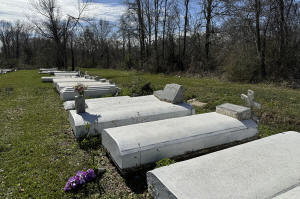National Park Service withdraws Black community in Louisiana from
historic landmark consideration
 Send a link to a friend
Send a link to a friend
 [February 25, 2025]
By JACK BROOK [February 25, 2025]
By JACK BROOK
WALLACE, La. (AP) — A Louisiana landscape of centuries-old sugar cane
plantations and enduring Afro-Creole culture along the Mississippi River
had been eligible for receiving rare federal protection following a
multi-year review by the National Park Service.
But this month, the agency withdrew the 11-mile (18-kilometer) stretch
of land known as Great River Road from consideration for National
Historic Landmark designation at the request of state officials, who
celebrated the move as a win for economic development.
Community organizations bemoaned the decision as undermining efforts to
preserve the rich yet endangered cultural legacies of free African
American communities that grew out of slavery.
The region, in the heart of Louisiana's heavily industrialized Chemical
Corridor in St. John the Baptist Parish, has been at the center of
conflicts between grassroots community groups challenging the expansion
of polluting industrial facilities and officials and business leaders
doubling down on their importance for sustaining local economies. The
area is among the most threatened by climate injustice in the nation,
according to the Environmental Defense Fund's climate vulnerability
index.

Ashley Rogers, executive director of the nearby Whitney Plantation, said
the decision to remove the Great River Road region from consideration
for federally granted recognition was due to the “changing priorities”
of the Trump administration, the latest blow to “a culture under
attack.”
“It’s 100% because of the politics of the current administration, it’s
not because we’ve suddenly decided that this place doesn’t matter,”
Rogers said.
A multi-year National Park Service study on the area completed in
October concluded that the “exceptional integrity” of the Great River
Road landscape conveys “the feeling of living and working in the
plantation system in the American South."
Plantation buildings are so well-preserved that director Quentin
Tarantino used them while filming “Django Unchained,” to capture the
antebellum era. But there's also a rich and overlooked history of the
enslaved people who worked the plantations, their burial sites likely
hidden in the surrounding cane fields and many of their descendants
still living in tight-knit communities nearby.
The study deemed the region eligible to gain the same federal
recognition as around 2,600 of the nation’s most important historical
sites, including Mount Vernon, George Washington’s estate and
Monticello, Thomas Jefferson’s residence.
However, the determination was “premature and untimely” given that a
grain terminal that threatened to impact historic properties was no
longer planned, said the National Park Service’s Joy Beasley, who
oversees the designation of historic landmarks, in a Feb. 13 letter to
the Army Corps of Engineers.
Beasley’s letter stated the reversal was prompted by a request from the
state’s Department of Environmental Quality, which is tasked with
regulating environmental protection and has made no secret of its
support for industrial expansion.
[to top of second column]
|

Flowers rest on a grave marker in the St. John the Baptist Parish
cemetery, Feb. 21, 2025, in Willow Grove, La. (AP Photo/Jack Brook)

The head of the department, Aurelia S. Giacometto, framed the
decision as freeing the region from federal meddling and oversight
and opening up pathways for development.
“I’m grateful that the Trump Administration understands that states
and localities are better at determining their interests relating to
clean air, water and developing industry than leaving crucial
decisions like those to Washington,” Giacometto said in a statement.
Port of South Louisiana CEO Paul Matthew said in a press release
that companies are clamoring to develop and expand along the
Mississippi River, which would improve quality of life and spur
economic growth without sacrificing cultural legacies.
“If you really want to lift people out of poverty, you get them work
and increase job opportunity,” Republican Gov. Jeff Landry said.
Local historical and community organizations believe the region can
instead improve its economy by focusing on preserving and promoting
its history.
Ramshackled homes and shuttered buildings in the area are endemic of
longstanding underinvestment in these communities, but it's not too
late to reverse this trend through means besides industrialization,
said Joy Banner, co-founder of the local nonprofit The Descendants
Project, which is restoring historical properties in Great River
Road.
Banner helped lead efforts to successfully halt the construction of
a towering $600 million industrial grain terminal that would have
been built in her hometown, the predominantly Black community of
Wallace — spurring the National Park Service's study. A spokesperson
for the Army Corps of Engineers said any future industrial
development in the Great River Road would still need to consider the
potential impacts on historical and cultural heritage.

In the region's Willow Grove neighborhood, 76-year-old Isabella
Poche still trims the grass and repaints the tombs at the cemetery
where her mother, sisters and other relatives were buried with help
from the Black community's generations-old mutual aid society she
now leads. Beyond the furrows of the sugar cane fields where her
family once worked, a large plantation home stands in the distance
by the river's bank. It's a peaceful place she hopes to see
protected.
“I don’t want to move anywhere else,” Poche said. “I've been here
all my life."
All contents © copyright 2025 Associated Press. All rights reserved
 |